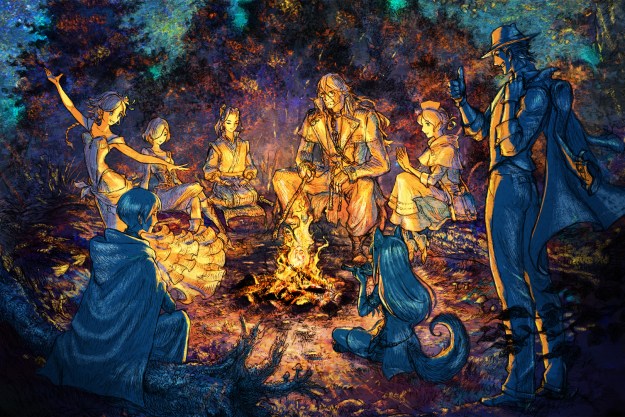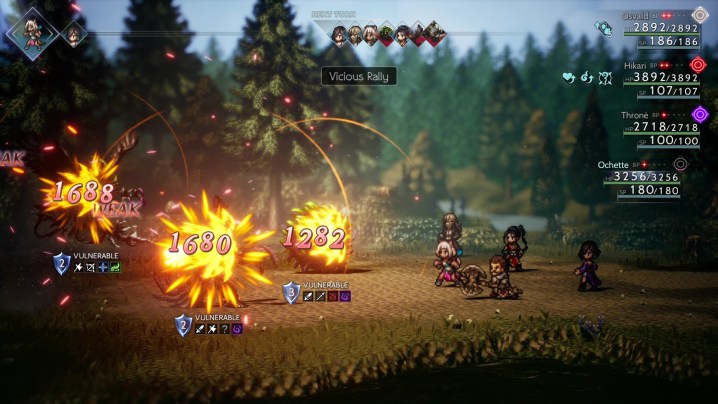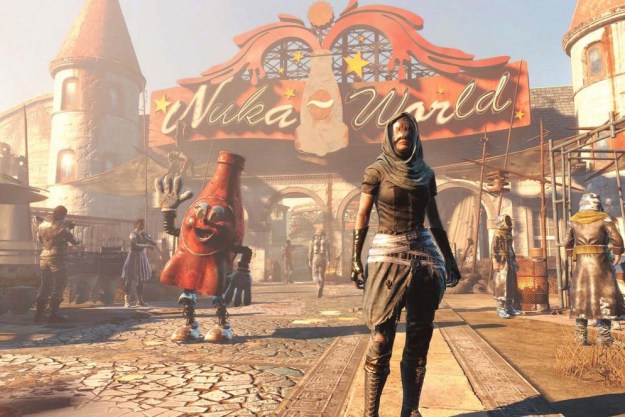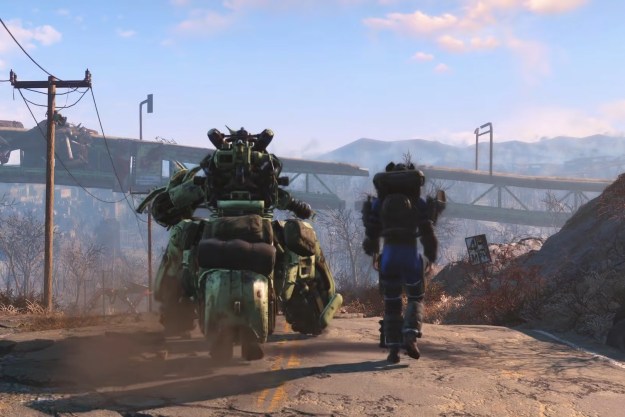
- Engaging battle system
- Improved character interactions
- Fantastic HD-2D visuals
- Excellent music
- Annoying difficulty spikes
- Uneven level pacing
When Octopath Traveler launched in 2018, it quietly kicked off a revolution. Square Enix’s retro RPG featured a unique art style that would usher in a new era of “HD-2D” games. The endearing pixel art complemented the 3D environments surprisingly well, resulting in Octopath Traveler’s timeless presentation. In the five years since it was released, other games such as Live a Live and Triangle Strategy have used the same style to great effect, whether it’s by breathing life into older titles or experimenting with other gameplay mechanics.
It wasn’t just style without substance, though. The first game made good use of its innovative art style with a fantastic turn-based battle system and robust customization options. Though it’s still one of the Switch’s standout RPGs, it did still have issues. Combat and art were on point, but limited interactions between its cast of heroes took some of the punch out of its eight-hero premise.
Five years later, Octopath Traveler 2 is here and seeks to remedy those issues from the first game, proving the series is more than a pretty face. It pulls that off for the most part thanks to strong visuals, music, and a battle system that still feels fresh. However, there are still some pain points of its predecessor that linger here, namely its grind-infested pacing and the occasional difficulty spike. The sequel is a definite level up, but there’s still room for the series to accrue experience.
Eight paths, eight stories
Octopath Traveler 2 takes place in Solistia, which is a much more industrialized setting than the first game’s Osterra. The mix of modern technology like the steam engine and magical elements like curses and prophecies makes for a fascinating location. Like the first game, the tale follows eight separate characters across the world. Each character has their own distinct story, such as Hikari, a swordsman on a mission to stop his brother’s war-mongering rule, and Castti, an apothecary with amnesia who’s trying to recover her memories by traveling and healing those in need. Players can pick and choose which character to start with, and then tackle each story’s chapters in any order from there.
Each story is intriguing in its own way and, importantly, never overstays its welcome. The scholar Osvald’s tale is particularly compelling as he’s on a revenge quest for the person who framed him for his family’s murder 20 years ago. I loved seeing Osvald tread down a dark path for vengeance, learning how far he would go to destroy those who wronged him. In Castti’s story, she learns harrowing details about the apothecary clan she belongs to. Along her journey, she wonders if she’s actually better off not remembering who she was before. Her altruistic-natured occupation as a healer directly conflicts with the sinister secrets that her clan holds.

The accompanying dungeons that punctuate each chapter are brisk in order to accommodate all eight characters in the main cast as well. Most of them consist of linear passageways with a boss at the end and some diverging paths every once in a while with a treasure chest. While the dungeon design is simple, it works well considering that you have to play through all eight characters, each of which has at least four chapters. Had dungeons been any more elaborate, they could have been a laborious chore to get through.
One of the biggest issues with the first Octopath Traveler is that the characters had very few crossovers between their own stories. The sequel unfortunately retains that same problem, though to a lesser degree. Osvald’s revenge quest doesn’t intersect with Castti’s journey to recover her own memories, which makes the narrative feel disparate rather than intricately woven together.
Crossover episodes provide tender moments between characters …
The sequel solves that issue to an extent via several unlockable crossover episodes between party members as you continue to progress through the game. These crossover episodes provide tender moments between characters that otherwise wouldn’t speak to each other at all during their individual character arcs. For instance, I enjoyed how Hikari and the dancer Agnea bonded over their love of music by listening to a guitarist play underneath the full moon. Agnea has the most light-hearted story of the entire cast as she wants to travel around the world and entertain people with her dancing, while Hikari takes a moment from stopping his bloodthirsty brother to enjoy the night sky view. The contrasting tones between their stories highlight how different their adventures are separately, but these crossover episodes portray these characters with more depth and how much they have in common.
The first Octopath game featured banter conversations between two characters after certain story events, where they would comment on what just unfolded. They were simply transported to some mysterious black void to have the conversation, though, interrupting the immersion. These make a return in the sequel, but this time around, the two characters can be seen talking with the appropriate city background behind them. It’s a minor change, but it makes the banter feel less alien and more part of the actual world. Banter scenes do lack voice acting though, which feels like the one missed opportunity in buffing the sequel’s approach to the story.
Keep stacking points
Octopath Traveler 2’s biggest selling point is its wonderful battle system, which largely remains unchanged from the first game. The turn-based combat utilizes the BP mechanic, where at the end of every turn, each character gets one BP and can hold a max of five BP at a time. Characters can use up to three BP per turn to either strike multiple times in the same turn or amplify a skill’s power.
The battle system encourages me to strategize and adapt to different situations on the fly.
It’s a fantastic spin on the traditional turn-based combat formula that makes you feel much more engaged with every single turn. Enemies also have numerical shields, which drastically decrease the amount of damage they take from your attacks. By striking an enemy’s elemental or weapon weakness, you can deplete their shields to zero which immobilizes them until their next turn and makes them take more damage.
The battle system encourages me to strategize and adapt to different situations on the fly. Perhaps I was going to launch an all-out offensive on a boss, but then it signals that it will unleash its ultimate attack on its upcoming turn. As a result, I now have to prioritize breaking its shield so it doesn’t happen. It’s a delicate balance between saving up your BP when you need it the most to break shields and trying to optimize the limited time you have before enemies recover them. There’s always an invigorating sense of tension in case the battle goes sideways. But when everything goes as planned, there’s immense satisfaction in unloading huge amounts of damage onto a boss.
The customization, by comparison, is rather straightforward. Each character has their assigned starting class like cleric and hunter. As you progress further into the game, characters are able to equip a second sub-class to give them access to even more skills. While the assigned starting class can’t be changed, the addition of a sub-class provides so much flexibility in how I’d build out my preferred party setup. I gave the thief, Thorne, the inventor subclass because she doesn’t have access to many weapon types to hit weaknesses with. The inventor had a catapult skill that had all the available weapon types, so that helped compensate for Throne’s flaws.

Though I’m high on the moment-to-moment gameplay, the RPG can have some frustrating difficulty spikes. As a result of its open-ended structure where you can progress each story in any order you’d like, there are times you’ll encounter a surprisingly hard boss. Luckily, you can leave at any time to tackle other stories simultaneously and up your characters if you’re having trouble with a particular boss. The issue, though, is inconsistent leveling. Only party members who participate in battle receive experience points. Each chapter has a recommended level for a character and so sometimes I felt like I had to needlessly grind so they could meet that threshold. Something like an experience share that the Pokemon series has would’ve been very helpful in preventing other characters from falling behind.
Oozing with style
Both the game’s art style and music shine here, which is no surprise considering it was the first game’s core feature. Take the presentation during big battles, for instance. Bosses are presented as larger-than-life and have a foreboding presence, even if they’re just normal-sized. In the merchant Partitio’s story, there’s a boss that looks like an innocent little dog outside of battle. But once you engage with it, its in-battle sprite balloons into a giant menacing bulldog.

The game’s electrifying soundtrack also adds to the excitement and hostility of combat. Outside of battle, there are different tracks to help highlight the diverse settings across Solista. Agnea’s hometown is a bustling city of entertainment, so it’s fitting that its theme features upbeat jazzy music that you’d hear in downtown Chicago. Hikari’s hometown of Kyu is filled with traditional Japanese flute music, befitting his eastern Asian-inspired roots.
Octopath Traveler 2 is a very beefy JRPG game that will easily last over 60 hours to even get to the end credits. There are a ton of customization options for characters and the battle system feels fun and enticing to play despite having some of the same issues that plagued the first one. Even with some of those lingering flaws begging to be ironed out, the sequel is enough of an improvement that I’m willing to join along for whatever journey comes next.
Octopath Traveler 2 was reviewed on Nintendo Switch.





